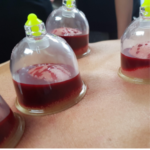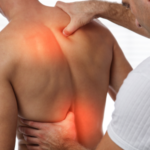
Boost Your Blood Flow: The Science Behind Hijama & Physiotherapy
Blood flow is the lifeline of our body, carrying oxygen, nutrients, and immune cells to every tissue and organ. On World Hemophilia Day, it’s crucial to highlight the importance of healthy blood circulation—not only for overall well-being but also for managing bleeding disorders like hemophilia. Poor blood flow can lead to muscle stiffness, delayed healing, and increased pain, making it harder for the body to recover from injuries. While modern medicine plays a vital role in managing hemophilia, natural and complementary therapies such as Hijama (cupping) and physiotherapy have gained attention for their ability to enhance circulation, reduce inflammation, and promote natural healing. In this blog, we’ll explore the science behind these therapies and how they can support better blood flow and overall health.
Hijama Therapy: Detoxify & Improve Circulation Naturally
 Hijama, or wet cupping, is an ancient therapeutic practice that involves creating suction on the skin and making small incisions to draw out stagnant blood and toxins. This process stimulates blood circulation, allowing fresh, oxygen-rich blood to flow more efficiently to tissues and organs. Improved circulation helps in flushing out metabolic waste, reducing muscle tension, and enhancing overall tissue health.
Hijama, or wet cupping, is an ancient therapeutic practice that involves creating suction on the skin and making small incisions to draw out stagnant blood and toxins. This process stimulates blood circulation, allowing fresh, oxygen-rich blood to flow more efficiently to tissues and organs. Improved circulation helps in flushing out metabolic waste, reducing muscle tension, and enhancing overall tissue health.
One of the key benefits of Hijama is its ability to relieve pain and inflammation naturally. By removing toxins and improving blood flow, it helps reduce swelling and stiffness in muscles and joints. Hijama also boosts the immune system by stimulating the production of white blood cells and promoting faster healing. This makes it particularly beneficial for individuals dealing with chronic pain, fatigue, and inflammatory conditions.
Dry vs. Wet Cupping: Which One Is Right for You?
Cupping therapy comes in two main forms: dry and wet cupping, each offering unique benefits. Dry cupping involves placing suction cups on the skin to create negative pressure, which increases blood flow, reduces muscle tension, and promotes relaxation. It’s commonly used for athletes and individuals with muscle stiffness, fatigue, or stress. Dry cupping helps loosen tight muscles and improve flexibility without any incisions or blood removal.
Wet cupping, on the other hand, includes making small incisions after suction to draw out stagnant blood and toxins. This method is more focused on detoxification and improving overall blood health. It’s particularly beneficial for individuals suffering from chronic pain, inflammation, or poor circulation. While dry cupping works well for muscle relaxation and stress relief, wet cupping targets deeper issues related to inflammation, toxins, and blood stagnation. Consulting a trained practitioner can help determine which method suits your specific health needs.
Physiotherapy for Circulation & Pain Management
 Physiotherapy plays a crucial role in improving blood circulation and managing pain through targeted exercises, manual therapy, and specialized techniques. By encouraging movement and stretching, physiotherapy helps increase blood flow to muscles and joints, enhancing oxygen delivery and nutrient absorption. This promotes faster healing, reduces muscle stiffness, and prevents the buildup of lactic acid, which can cause discomfort and fatigue.
Physiotherapy plays a crucial role in improving blood circulation and managing pain through targeted exercises, manual therapy, and specialized techniques. By encouraging movement and stretching, physiotherapy helps increase blood flow to muscles and joints, enhancing oxygen delivery and nutrient absorption. This promotes faster healing, reduces muscle stiffness, and prevents the buildup of lactic acid, which can cause discomfort and fatigue.
Techniques such as massage therapy, electrical stimulation, and heat therapy are often used to relax muscles and improve circulation. Strengthening exercises and mobility training also help in enhancing joint function and reducing the risk of injury. For individuals with conditions like hemophilia, where joint health and bleeding risks are major concerns, physiotherapy can provide safe and effective pain relief while improving overall physical strength and flexibility.
Cupping for Athletes & Muscle Recovery
Cupping therapy has become increasingly popular among athletes for its ability to speed up post-workout recovery and reduce muscle soreness. The suction created by the cups increases blood flow to targeted muscles, helping to flush out lactic acid and metabolic waste that accumulate after intense exercise. This enhanced circulation promotes faster muscle repair, reduces stiffness, and prevents delayed onset muscle soreness (DOMS).
By relaxing tight muscles and improving tissue elasticity, cupping also enhances flexibility and overall athletic performance. It helps release muscle knots and trigger points, allowing athletes to move more freely and with less discomfort. Many professional athletes use cupping as part of their recovery routine to maintain peak performance and reduce the risk of injury during training and competition.
Book Your Therapy Session at Nuvida
If you’re looking to improve your blood circulation, relieve pain, and enhance overall well-being, Nuvida offers expert-guided cupping and physiotherapy sessions tailored to your needs. Our trained therapists specialize in both dry and wet cupping, helping you detoxify, reduce muscle tension, and boost recovery. Whether you’re an athlete aiming to enhance performance or someone seeking relief from chronic pain, our personalized approach ensures you get the best care possible.
Good blood circulation is essential for overall health and healing, especially for individuals managing conditions like hemophilia or dealing with muscle recovery. Therapies like Hijama (cupping) and physiotherapy offer natural, effective ways to improve blood flow, reduce pain, and enhance recovery. At Nuvida, we combine modern physiotherapy techniques with the ancient healing art of cupping to provide a holistic treatment experience. Take the first step toward better health and recovery—book your therapy session today and feel the difference improved circulation can make!



Leave A Comment